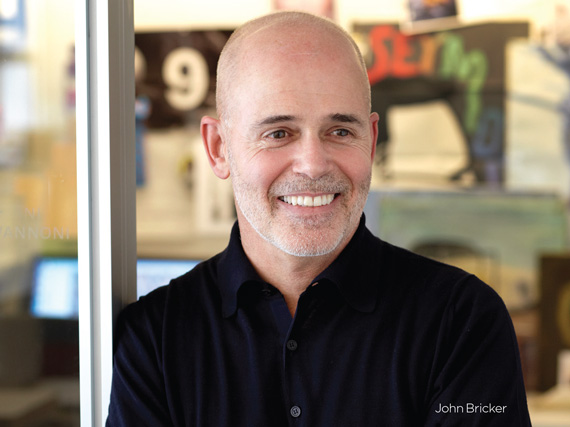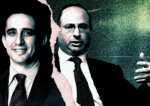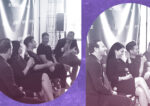Trending
The maestro of brand design
Gensler's John Bricker thrives on coaxing out retail companies' core concepts

Whether the project involves high fashion, toy stores or even the NBA, Gensler’s creative director, John Bricker, knows a thing or two about corporate brands — sometimes even better than his clients, he says. He oversees the creative direction of the entire international architecture and design firm as well its branding studio, which he started 35 years ago as a freshly minted Arizona State grad. Some of his notable clients include Barney’s New York, Neiman Marcus and the former Toys “R” Us flagship store in Times Square. Inside an office adorned with works by Andy Warhol and Barbara Kruger, Bricker tells The Real Deal about his first experience with omnichannel retailing and what branding means today.
As a graphic designer, how were you able to establish a retail and branding studio?
Our organization is very entrepreneurial and over the course of time I didn’t want to just do signage and wayfinding. I saw other opportunities because of our relationships with clients. And I also had a belief that, especially working in the sector of retail and lifestyle, brand is so centric to how we look at design when it comes to built environments.
Strategists come up with the words and the descriptions and the personality of a brand, and we use that as a foundation of a project in which the architect’s responsibility is to manifest that brand into a 3-D environment.
So I found myself in a place where I was playing a role of liaison between the client and the team. Over the course of time … we’ve really developed this strong integrated practice.
My first project we applied this to was for Hold Everything, which was owned by William Sonoma … but it was a catalog business and the managers decided to do a store.
We had to take a catalog and turn it into something that was an interesting, compelling retail experience. That really put us on the path. It was then what smaller Web companies are today.
Now, online clients are coming to us and saying, “We want to be in traditional retail now not just online.”
How do you translate an online business into a storefront retail business?
The personality, the attitudes the company stands for, taking those words and ideas and translating them into a built space. For instance, “brand is transparent.” What does that mean? Well, obviously how you extrapolate that into a design motif suggests that the space may be open or walls may not be solid; they may be more translucent, et cetera. Those are obvious design moves, but it’s really more about unique characteristics about a brand that get personalized or translated in a very unique solution [people] can own.
What are some examples from recent projects?
I finished a prototype last year for Havaianas, the flip-flops company that is moving into a global presence as a lifestyle brand … And in translating the essence of a Brazilian lifestyle into a store environment, we used cues that were rather fun and clever. The ceiling element was lit in a sense that you felt it was daylight and on the beach. We created this focal point that is a palm tree in a very abstract sense. All the palm fronds are made out of straps from flip-flops. We’re playing with a little bit of whimsy, but it’s all just moments that are intrinsically Brazilian.
What are some other projects you’re working on?
We just finished Cadillac’s headquarters, which has moved from Detroit to here in New York City to make a major statement change about where it’s going as a brand. The whole goal is “to make Cadillac cool again,” and we’re designing a destination experience center that will be called Cadillac House in Soho. It will have cars in it, but it’s not selling cars. It’s more about the partnerships and the connection to what Cadillac staffers call “the creative class.” They’re going after a younger audience, and they’re partnering with various fashion brands and design entities.
What are some retail design trends that are especially salient in 2016?
Brands can’t just be one thing to one customer segment anymore. They need to be a broader mind-set and ultimately they must make an emotional connection. I think that built environments are really important today. There used to be communities out there of like-minded people that are not connected geographically. But with social media, they’re now connected through a network. And the influence and power they have in the conversation of brands is huge. And that’s having an impact in terms of consumer interest.
But the world of the Web and social environment does not replace built environments. So I may have a brand I’m comfortable with buying online and I’ve got my tribe of people who are big believers in that brand. But to have a place to go to and really experience a brand is more important these days. As a result, a lot of our clients are asking us to design a space that’s not just purely about the purchase. It’s about experience and social connection and community, programming the space and driving desire to go to a space that we cannot experience online.
More and more, ethics play into people’s consumer decisions. You don’t want it to be marketing speak; you want it to be true. I think for brands to find their own truths is difficult.
What are some other difficulties in your job?
Brands today have to learn to continually not remain idle. And it really has to be a holistic approach to design. It’s difficult for us designers to respond to that because we’re working with a built environment. When we’re done, we’re done: Here are the keys.
So a lot of the time, it’s about how the space could evolve. We have to be intelligent about how we keep things fresh.
Could a brand get in the way of its product?
Possibly. There’s a wonderful animated video of two people talking about the iPhone. There’s the consumer, who only wants the iPhone, and a salesperson, who explains how the iPhone is not as good as everything else, and it’s hysterical.
But what it did say is that we can become victims of brands. And we forget there may be other options, and Apple is a good example of it.
Brands can seduce people. It may not be about the quality of the product in the end.
It’s not a bad thing; it’s just a different sensibility.
This interview has been edited and condensed for clarity.




